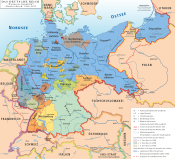Free State of Bottleneck
Free State Bottleneck Freistaat Flaschenhals | |||||||||
|---|---|---|---|---|---|---|---|---|---|
| 1919–1923 | |||||||||
| Status | Unoccupied territory within post-WWI Germany | ||||||||
| Capital | Lorch | ||||||||
| Government | Republic | ||||||||
| President | |||||||||
| Historical era | Interwar period | ||||||||
• Established | 10 January, 1919 1919 | ||||||||
| 23 February 1923 1923 | |||||||||
| Population | |||||||||
• 1920 | 8,000 | ||||||||
| Currency | Freistaattaler | ||||||||
| |||||||||
The Free State Bottleneck (German: Freistaat Flaschenhals) was a short-lived quasi-state that existed from 10 January 1919 until 25 February 1923. It was formed out of part of the Prussian province of Hesse-Nassau as a consequence of the French and American occupation of the Rhineland following World War I. The Bottleneck is now part of the modern German states of Hesse and Rhineland-Palatinate.
Creation
Following the Armistice of 1918, Allied forces occupied the German territory west of the Rhine. To maintain a military presence on the eastern side, the Allied powers extended their zones of occupation by creating three semi-circular bridgeheads of 30 km radius, radiating from Cologne (British zone), Koblenz (American zone), and Mainz (French zone).
Because of an error in measurement, the French and American zones did not meet. The resulting gap on the eastern side of the Rhine contained the Wisper valley, the towns of Lorch and Kaub, and villages of Lorchhausen, Sauerthal, Ransel, Wollmerschied, Welterod, Zorn, Strüth and Egenrod. Surrounded by the two Allied bridgeheads, the Taunus range to the north-east, and the Rhine to the south-west, this tiny region was effectively cut off from the rest of Germany and subsequently separated from the administration of the Weimar Republic. Owing to the circular nature of the Allied bridgeheads, this enclosed territory took on the shape of a bottleneck, hence the name that was given to the microstate, when it was declared on 10 January 1919.
Life in the Bottleneck
The region contained approximately 8000 people and its largest town, Lorch, was established as its capital. The mayor of Lorch, E. Pnischeck, was subsequently elected as president of this small territory. Pnischeck headed the Bottleneck's administration for the time of its existence, which even oversaw the production of its own stamps and currency.
There were no roads connecting the Bottleneck to unoccupied Germany, trains were not permitted to stop there, and air or river transportation was impossible. The movement of goods and post to and from the state was only made possible by smuggling. One time, a French train loaded with coal from the Ruhr valley was hijacked from neighbouring Rüdesheim and taken to the Bottleneck, where the coal was distributed among the populace for heating purposes.[1]
Foreign relations
The state issued its own passports to its citizens, and had plans to establish an embassy in Berlin. Furthermore, it was intended to establish diplomatic relations with other countries, but the state ceased to exist before these plans were realised.[2]
Abolition
After four years of existence, the Free State Bottleneck was abolished on 23 February 1923 following the French Occupation of the Ruhr. The Bottleneck was eventually reincorporated with the Prussian province of Hesse-Nassau.

The Bottleneck today
The territory that formerly comprised the Bottleneck is now part of the Rhine Gorge UNESCO World Heritage Site. The history of the Bottleneck is now a tourist attraction in the area, particularly in the former Free State's major towns of Lorch and Kaub.
Bottleneck stamps and currency are now sought-after rarities. Wine that was smuggled in from occupied Germany and stored in Lorch and Kaub can also fetch high prices.
See also
References
External links

